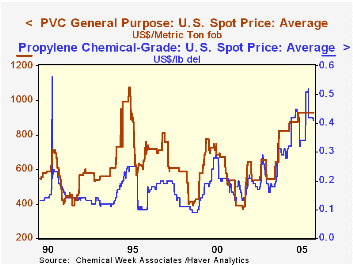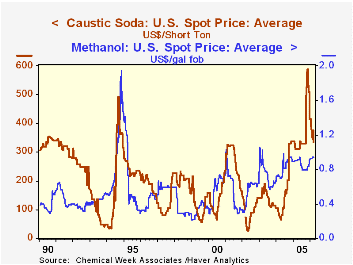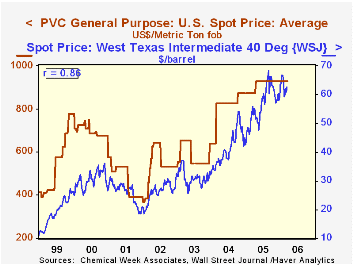 Global| Mar 23 2006
Global| Mar 23 2006Chemical Prices Surge with Petroleum, But Some Stabilize or Even Decline Recently
Summary
Besides its wide array of macroeconomic databases, Haver Analytics also features a number of industry offerings. Just this morning, for example, Chemical Week magazine released its weekly report on chemical prices. These are [...]

Besides its wide array of macroeconomic databases, Haver Analytics also features a number of industry offerings. Just this morning, for example, Chemical Week magazine released its weekly report on chemical prices. These are maintained in Haver's CHEMWEEK database. Far from being esoteric trivia, the chemicals in this collection are main building blocks of products and fuels consumers use every day. If not ingredients in the items themselves, several of these chemicals are important in the manufacturing process.
The database consists of 29 major chemicals. We list just four in the table below as a sampling. The prices we show here averages; "highs" and "lows" are also available. These are US spot prices; spot prices are also given for European markets and contract prices for several specific delivery months are available for most items for both US and European markets.
The particular items we show here are multipurpose chemicals. Many plastics are made from polyvinyl chloride and combinations of propylene with various other substances. Both have experienced a near doubling over the past couple of years, but have shown some signs of stabilizing so far this year. PVC is a hard plastic, frequently used now in pipes, as in household plumbing, and other building products, such as vinyl siding. Its price has been steady now since last April at $930 per metric ton. However, the price rose in steep steps from just $370/MT in early 2002.
Propylene is an ingredient in other products, such as aerosol sprays, other plastics and fibers and synthetic rubber. Its price has more than tripled since early 2002, when it traded at just $0.13/pound, compared with as much as $0.52 briefly in late November and $0.41 most currently.
Methanol, or wood alcohol, was once thought to be a potential substitute or complement to gasoline in motor vehicle fuels. Racecars and some specialty vehicles do run on it. However, it is also highly toxic, causing safety concerns. So other items, such as ethanol, are developing more as alternative fuels. This shift in potential usage may be reflected in the price trend for methanol. It has risen markedly, from $0.57/gallon in late 2003 to $0.94 recently, but on a relative basis, it has moved much less than other chemicals, as is evident in the second graph.
Finally, the price of caustic soda is also up dramatically. Caustic soda is more familiarly known as lye and its more formal chemical name is sodium hydroxide. It is a very widely used in the manufacture of such diverse items as aluminum, textiles, soap and paper and in petroleum refining. As recently as the spring of 2004, this key substance was selling for as little as $65 a ton. But in November, it reached $587.50 before falling back to "just" $335 in the last couple of weeks.
The mere wide ranges covered by these price movements highlight the value of the CHEMWEEK database. Unlike many commodities that have tighter markets, these chemical prices often seem to move in fits and spurts, sometimes doubling virtually "overnight". So monitoring them would seem vital for industry analysts and even macroeconomists.
Further, several are closely tied to petroleum prices. In the third graph, for instance, we show the simple spot price for crude oil, West Texas Intermediate, from the WEEKLY and OILWKLY databases. It has a high 86% correlation with PVC prices since 1999 and as high or for even longer periods with numerous other chemicals. So the role of oil is closely intertwined not only with heating and driving costs, but also with the raw material and processing costs for many other products.
| US Spot Prices | Mar 22, 2006 | Feb 22, 2006 | End-Dec 2005* | 2005 | 2004 | 2003 |
|---|---|---|---|---|---|---|
| PVC General Purpose, $/metric ton | 930 | 930 | 930 | 914 | 810 | 585 |
| Propylene, Chemical Grade, $/lb | 0.41 | 0.41 | 0.42 | 0.41 | 0.31 | 0.20 |
| Methanol, $/gal | 0.94 | 0.94 | 0.91 | 0.86 | 0.82 | 0.73 |
| Caustic Soda, $/short ton | 335 | 345 | 415 | 369 | 176 | 139 |
| Memo: Crude Oil, $/bbl** | 62.69 | 60.00 | 59.49 | 56.29 | 41.31 | 31.14 |
Carol Stone, CBE
AuthorMore in Author Profile »Carol Stone, CBE came to Haver Analytics in 2003 following more than 35 years as a financial market economist at major Wall Street financial institutions, most especially Merrill Lynch and Nomura Securities. She had broad experience in analysis and forecasting of flow-of-funds accounts, the federal budget and Federal Reserve operations. At Nomura Securities, among other duties, she developed various indicator forecasting tools and edited a daily global publication produced in London and New York for readers in Tokyo. At Haver Analytics, Carol was a member of the Research Department, aiding database managers with research and documentation efforts, as well as posting commentary on select economic reports. In addition, she conducted Ways-of-the-World, a blog on economic issues for an Episcopal-Church-affiliated website, The Geranium Farm. During her career, Carol served as an officer of the Money Marketeers and the Downtown Economists Club. She had a PhD from NYU's Stern School of Business. She lived in Brooklyn, New York, and had a weekend home on Long Island.





